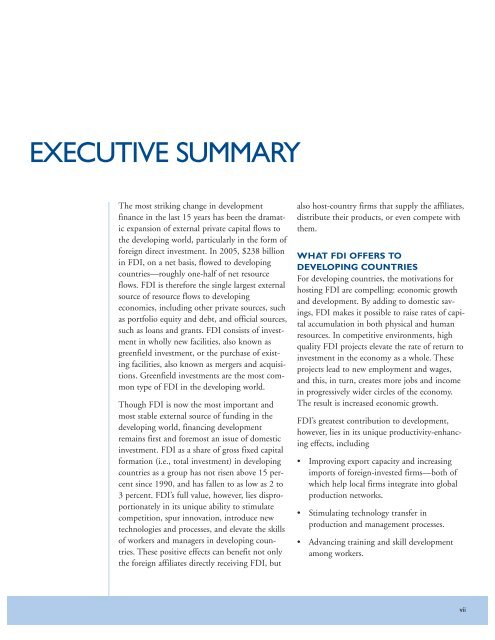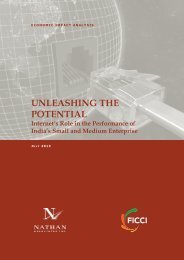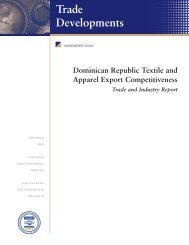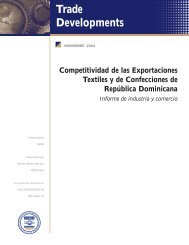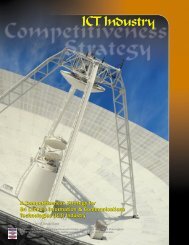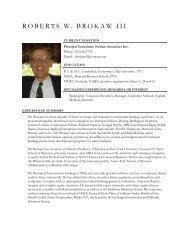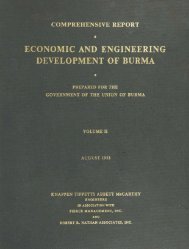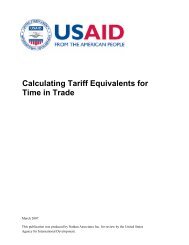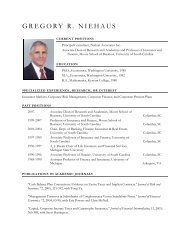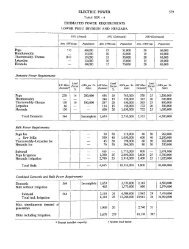Putting it to Work in Developing Countries - Nathan Associates
Putting it to Work in Developing Countries - Nathan Associates
Putting it to Work in Developing Countries - Nathan Associates
You also want an ePaper? Increase the reach of your titles
YUMPU automatically turns print PDFs into web optimized ePapers that Google loves.
EXECUTIVE SUMMARY<br />
The most strik<strong>in</strong>g change <strong>in</strong> development<br />
f<strong>in</strong>ance <strong>in</strong> the last 15 years has been the dramatic<br />
expansion of external private cap<strong>it</strong>al flows <strong>to</strong><br />
the develop<strong>in</strong>g world, particularly <strong>in</strong> the form of<br />
foreign direct <strong>in</strong>vestment. In 2005, $238 billion<br />
<strong>in</strong> FDI, on a net basis, flowed <strong>to</strong> develop<strong>in</strong>g<br />
countries—roughly one-half of net resource<br />
flows. FDI is therefore the s<strong>in</strong>gle largest external<br />
source of resource flows <strong>to</strong> develop<strong>in</strong>g<br />
economies, <strong>in</strong>clud<strong>in</strong>g other private sources, such<br />
as portfolio equ<strong>it</strong>y and debt, and official sources,<br />
such as loans and grants. FDI consists of <strong>in</strong>vestment<br />
<strong>in</strong> wholly new facil<strong>it</strong>ies, also known as<br />
greenfield <strong>in</strong>vestment, or the purchase of exist<strong>in</strong>g<br />
facil<strong>it</strong>ies, also known as mergers and acquis<strong>it</strong>ions.<br />
Greenfield <strong>in</strong>vestments are the most common<br />
type of FDI <strong>in</strong> the develop<strong>in</strong>g world.<br />
Though FDI is now the most important and<br />
most stable external source of fund<strong>in</strong>g <strong>in</strong> the<br />
develop<strong>in</strong>g world, f<strong>in</strong>anc<strong>in</strong>g development<br />
rema<strong>in</strong>s first and foremost an issue of domestic<br />
<strong>in</strong>vestment. FDI as a share of gross fixed cap<strong>it</strong>al<br />
formation (i.e., <strong>to</strong>tal <strong>in</strong>vestment) <strong>in</strong> develop<strong>in</strong>g<br />
countries as a group has not risen above 15 percent<br />
s<strong>in</strong>ce 1990, and has fallen <strong>to</strong> as low as 2 <strong>to</strong><br />
3 percent. FDI’s full value, however, lies disproportionately<br />
<strong>in</strong> <strong>it</strong>s unique abil<strong>it</strong>y <strong>to</strong> stimulate<br />
compet<strong>it</strong>ion, spur <strong>in</strong>novation, <strong>in</strong>troduce new<br />
technologies and processes, and elevate the skills<br />
of workers and managers <strong>in</strong> develop<strong>in</strong>g countries.<br />
These pos<strong>it</strong>ive effects can benef<strong>it</strong> not only<br />
the foreign affiliates directly receiv<strong>in</strong>g FDI, but<br />
also host-country firms that supply the affiliates,<br />
distribute their products, or even compete w<strong>it</strong>h<br />
them.<br />
WHAT FDI OFFERS TO<br />
DEVELOPING COUNTRIES<br />
For develop<strong>in</strong>g countries, the motivations for<br />
host<strong>in</strong>g FDI are compell<strong>in</strong>g: economic growth<br />
and development. By add<strong>in</strong>g <strong>to</strong> domestic sav<strong>in</strong>gs,<br />
FDI makes <strong>it</strong> possible <strong>to</strong> raise rates of cap<strong>it</strong>al<br />
accumulation <strong>in</strong> both physical and human<br />
resources. In compet<strong>it</strong>ive environments, high<br />
qual<strong>it</strong>y FDI projects elevate the rate of return <strong>to</strong><br />
<strong>in</strong>vestment <strong>in</strong> the economy as a whole. These<br />
projects lead <strong>to</strong> new employment and wages,<br />
and this, <strong>in</strong> turn, creates more jobs and <strong>in</strong>come<br />
<strong>in</strong> progressively wider circles of the economy.<br />
The result is <strong>in</strong>creased economic growth.<br />
FDI’s greatest contribution <strong>to</strong> development,<br />
however, lies <strong>in</strong> <strong>it</strong>s unique productiv<strong>it</strong>y-enhanc<strong>in</strong>g<br />
effects, <strong>in</strong>clud<strong>in</strong>g<br />
• Improv<strong>in</strong>g export capac<strong>it</strong>y and <strong>in</strong>creas<strong>in</strong>g<br />
imports of foreign-<strong>in</strong>vested firms—both of<br />
which help local firms <strong>in</strong>tegrate <strong>in</strong><strong>to</strong> global<br />
production networks.<br />
• Stimulat<strong>in</strong>g technology transfer <strong>in</strong><br />
production and management processes.<br />
• Advanc<strong>in</strong>g tra<strong>in</strong><strong>in</strong>g and skill development<br />
among workers.<br />
vii


